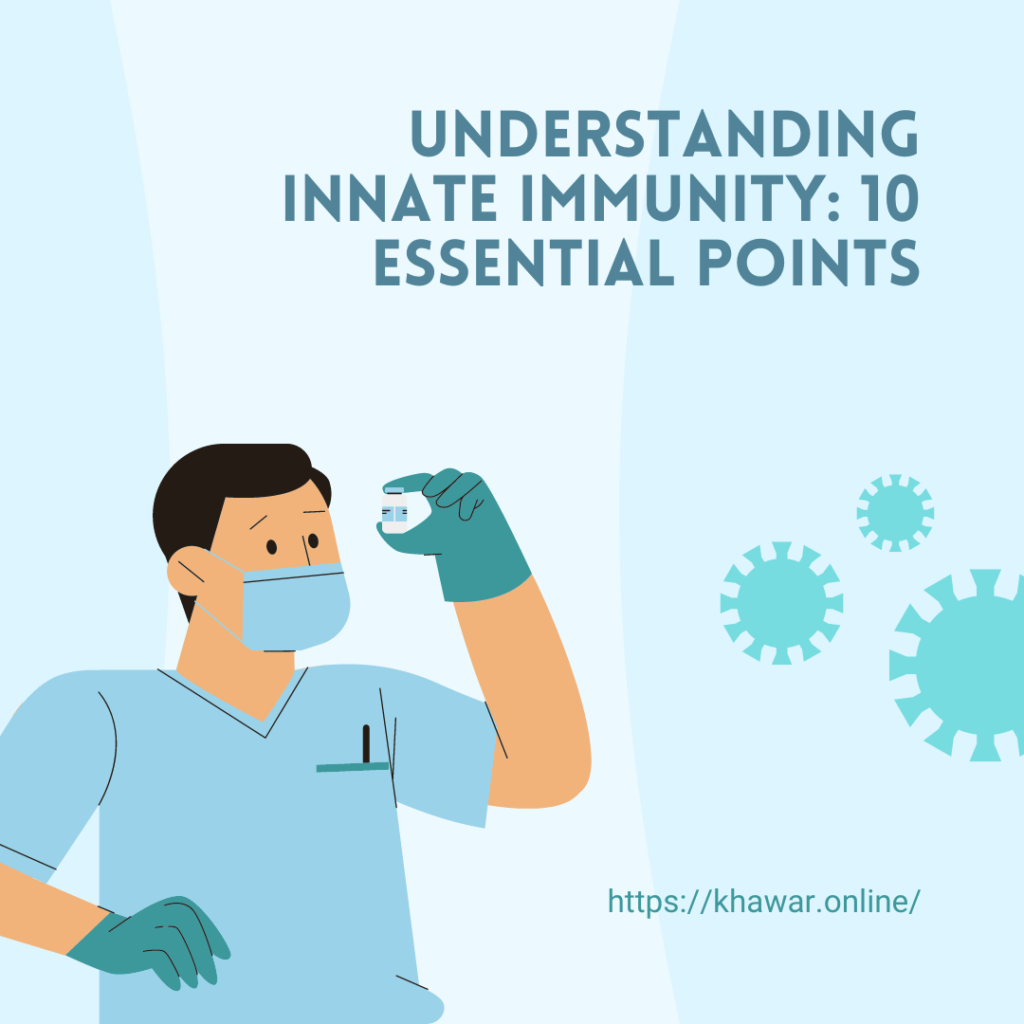Outline of the Innate Defense

The initial defense mechanism of our body against infections is innate immunity. Providing instant protection, it is an essential component of the immune system. Immune system and adaptive immunity are not the same. It is non-specific to have innate immunity. It functions without a history of infection. It is essential to comprehend innate immunity. It makes clearer to us how our bodies fend off illnesses and maintain their health.
How does one define innate immunity?
An individual’s innate immunological responses are referred to as innate immunity. There are numerous obstacles in it. They have three forms: chemical, biological, and physical. They obstruct the entry of infections into the body.
Synopsis and Fundamental Ideas
The body reacts to pathogens right away with innate immunity. There are always-on systems involved. Ready to repel a wide variety of intruders, they are. Once exposed to a pathogen, adaptive immunity takes time to develop. Activation of innate immunity occurs.
Innate Immunity Components
Three elements comprise innate immunity. They consist of: mucous membranes and skin, which act as physical obstacles. in addition to chemical barriers such as acids and enzymes. biological obstacles are additional. The body’s natural flora is one of them.
Crucial Innate Immunity Mechanisms
To keep the body safe from infections, innate immunity uses a number of strategies. These systems remain vigilant and prepared to counter any potential dangers.
Anatomical Divides
Analytical barriers comprise the initial line of defense. In order to keep infections out of the body, the skin serves as a physical barrier. The urogenital, digestive, and respiratory tracts’ mucous membranes catch and eliminate germs. Enzymes found in bodily secretions like saliva and tears kill invaders.
A Flare-up
Within innate immunity, inflammation is a crucial response. Inflammatory mediators like cytokines are released by tissues that are injured or infected. Circulation in the area is improved by this approach. To combat the infection, it increases the number of immune cells. Vermilion, warmth, edema, and pain are indicators of inflammation.
The Phagocytosis
Some cells ingest and break down infections through a process called phagocytosis. Macronuclear cells, dendritic cells, and neutrophils are important phagocytic cells. The foreign invaders are identified, consumed, and eliminated by these cells.
Balanced System
Proteins make up the complement system. The capacity of phagocytic cells and antibodies to eliminate infections is enhanced. Along with promoting phagocytosis and inflammation, it aids in the lysis of invasive cells.
The Parts of Immunity That Are Cellular
Innate immunity depends heavily on a number of different kinds of white blood cells. Every variety plays distinct roles in bolstering the body’s defensive systems.
Leukemic Cells
The immune system depends heavily on leukocytes, or white blood cells. Basophils, mast cells, and natural killer cells are a few instances. Innate immunity is mediated by these cells. Assailant cells are targeted by natural killer cells. Inflammatory substances are secreted by basophils and mast cells.
Protein Recognition Receptors (PRRs)
Immune cell PRRs are proteins. They identify particular pathogen patterns. Toll-like receptors are one example (TLRs). Upon detecting these patterns, PRRs initiate immunological responses.
Relationships with Immune System Adaptation
Together with adaptive immunity, innate immunity functions. Taken together, they offer a potent barrier against illnesses. An organized and successful immune response is ensured by this interaction.
Display of Antigens
An essential part of phagocytic cells is the presentation of antigens to T cells by dendritic cells. For the adaptive immune responses to begin, this procedure is crucial. Antigens are displayed by dendritic cells. In recognizing and reacting to pathogens, this aids the immune system.
Adaptive Immunity and Innate Immunity Interact
Constant interaction exists between the innate and adaptive immune systems. Initially, there is innate immunity. About pathogens, it informs the adaptive system. An effective and timely immune response is ensured by this dialogue.
Value of Innate Immunity in Clinical Settings
Comprehending the function of innate immunity in health and illness is essential. Treatments and preventative measures are developed with its assistance.
Disease and Health-Related Innate Immunity
The defense against pathogens is innate immunity. First line of defense against infections is it. Still, illnesses can result from innate immunity malfunction. Chronic inflammation and autoimmune diseases are associated with compromised innate immunity.
Therapeutic Uses
Plans are underway to develop therapeutic approaches that specifically target innate immunity. Innate immune response-boosting medications and vaccinations are among them. Treatments of infections and inflammatory illnesses can be assisted by such therapy.
To Sum Up
The body’s quick and general defense against infections is known as innate immunity. Proteins, cells, and obstacles abound in it. In concert, they provide the body with protection. The intricacy and effectiveness of our immune system are better understood when these systems are comprehended. Good decisions and medical attention can strengthen innate immunity, which improves health. Better wellbeing is another benefit.
A FAQ
Innate immunity: what are some examples?
Membranes, phagocytic cells, skin barriers, and the complement system are a few examples.
What is the mechanism of innate immunity?
Bodies, chemicals, and other barriers are all overcome by innate immunity. The complement system, phagocytosis, and inflammation are also employed.
Why is there no specificity in innate immunity?
It is non-specific to have innate immunity. Instead of focusing on particular antigens, it reacts to infections generally.
Innate immunity comes in two varieties.
Mucous membranes and skin are examples of the two types of physical barriers. Phagocytic cells and the complement system are examples of internal defenses.
How does one define innate immunity?
First line of defense against pathogens in the body is innate immunity. Though it offers general protection, it does so instantly.
How many barriers are present in innate immunity and how does it function?
Many hurdles are overcome by innate immunity. These three categories are biological (normal flora), chemical (enzymes), and physical (skin). Along with phagocytic cells, it also involves inflammatory reactions.
